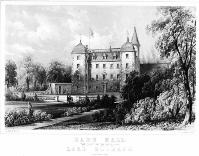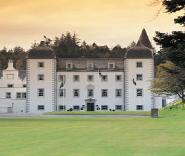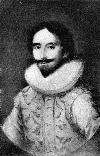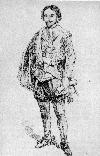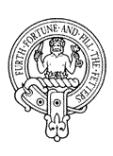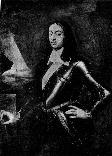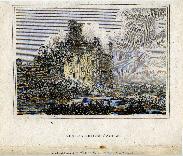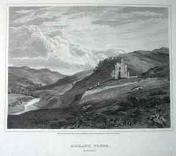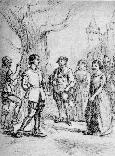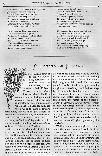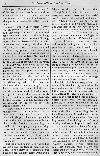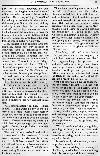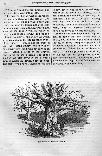See also
- Andrew MURRAY's parents: John MURRAY ( -1513) and Isobel HOPPAR ( - )
- Andrew MURRAY's siblings: Agnes MURRAY ( - ) and Margaret MURRAY ( - )
Sir Andrew MURRAY ( -1572)
1. Sir Andrew MURRAY, son of John MURRAY ( -1513) and Isobel HOPPAR ( - ), married Elizabeth LOCKHART circa [Julian] 14 June 1533. He married Grissel SCOTT (NEE BETHUNE) on 8 February 1551. He died on 1 September 1572.
Became ... of Blackbarony. Was a zealous Protestant. He had two sisters.
On his residence, Darn Hall -
"GHOST HUNT AT BARONY CASTLE, SCOTTISH BORDERS"
Built in 1536, this stunning manor house is set in 25 acres of woodland, complete with amazing views of the Tweed Valley. It is now a luxurious hotel and conferencing venue owned by Devere Venues.
The history of Barony Castle is frustratingly hazy. Believed to have been commissioned by Sir Andrew Murray, it was initially built as a border tower. It later served as a family home for many years for the Murrays, an influential family in Scottish history. Originally known as Darn Hall, it is sometimes also referred to as Black Barony Castle. An old illustration can be seen on the right, depicting Darn Hall from several hundred years ago.
John Murray, son of Andrew, was responsible for enclosing the lands and developing the property into a mansion. According to records, John was knighted on the spot after announcing to King James VI (James I of England, who would later be the target of the Gunpowder Plot) the birth of his first son, Henry, Prince of Wales.
Sir Andrew Murray's other son, Gideon Murray, would later become Lord Elibank, firm favourite of King James VI. It appears that during his later years in politics he acted as Royal Treasurer for Scotland and as such was responsible for the repair and improvement of many Scottish Royal properties, notably Linlithgow Palace. It is unclear how much of his time was spent at Barony, as his main home was at nearby Elibank Castle, the ruins of which can still be seen today. It was there to which he fled after falling from favour with the King, after rumours of financial mismanagement meant that he was due to be put on public trial. Mortally offended, he took to his bed and went on hunger strike, dying after two weeks of refusing food and water. Ironically, after his death, James completely exonerated him from any wrongdoing.
Gideon did, however, leave one legacy. His daughter, Agnes Murray, was the subject of 'Muckle Mou'd Meg', a legend well known to any Scot! For those south of the border, this strange tale can be read here. Walter Scott, a descendant of Agnes, referred to her ghost haunting Barony Castle and witnessed it himself while staying there.
Barony Castle now holds more than a passing interest for those interested in the paranormal, for there are many curious stories of hauntings within its walls. Since it has been a hotel so many guests have reported strange goings on that a form is now left in each room for guests to fill in if they happen to experience anything out of the ordinary.
The last Murray to live in the house was Alexander Fox Murray, who sold it as a hotel in 1927. It is believed to be his apparition who appears in the Tweeddale room, as if sitting in a rocking chair and staring at the fireplace, which was bricked up in the late eighties. He ignores any witnesses and slowly fades away, accompanied by the smell of cigar smoke and brandy. Many people have seen his ghost and he is now known affectionately as 'Auld Reekie'.
].
Sir Andrew Murray was a zealous protestant. He is believed to have commissioned Barony Castle (originally Darn Hall), which later served as a family home for many years for the Murray family.
Elizabeth LOCKHART was the daughter of William LOCKHART ( - ). She and Andrew MURRAY had the following children:
| +2 |
Grissel SCOTT (NEE BETHUNE), daughter of Sir John BEATON (2nd of Creich) ( - ) and Janet HAY ( - ), died on 18 August 1579. She and Andrew MURRAY had the following children:
| +3 | |
| +4 | |
| +5 | |
| +6 | |
| +7 | |
| +8 |
Second Generation
2. Marion MURRAY, daughter of Sir Andrew MURRAY and Elizabeth LOCKHART, married James PRINGLE on [Julian] 14 December 1566. She died in [Julian] May 1585 in Whitebank.
3. Sir John MURRAY of Blackbarony, son of Sir Andrew MURRAY and Grissel SCOTT (NEE BETHUNE), was a MP for Peebles. He died on 3 July 1609. He married Margaret HAMILTON. He married Margaret WAUCHOPE.
... of Blackbarony. John was knighted at Stirling on announcing to King James VI the birth of his eldest son Henry, Prince of Wales. He was mainly responsible for enclosing the lands at Darn Hall and developing the property from a border tower to a mansion.
4. Andrew MURRAY, son of Sir Andrew MURRAY and Grissel SCOTT (NEE BETHUNE), died before [Julian] 2 June 1587.
5. Sir Gideon MURRAY, son of Sir Andrew MURRAY and Grissel SCOTT (NEE BETHUNE), was born on 1 January 1559. He had the title 'Lord Elibank'. He was a MP for Selkirk, Treasurer-Depute for Scotland. He died on 29 June 1621. He married Margaret PENTLAND.
Sir Gideon Murray of Elibank, politician and judge, was the third son of Sir Andrew Murray of Blackbarony, Peebleshire, and Grisel Bethune, daughter of Sir John Bethune of Criech in Fife and widow of William Scott of Buccleuch.
Murray attended the University of Glasgow, from which he graduated with an MA in 1581. Soon afterwards he entered the ministry as minster of the parsih of Auchterless in Aberdeenshire. His career in the church was however cut short by Murray's killing of a man named Atchison in 1585, for which crime he was imprisoned in Edinburgh Castle. The Countess of Arran, wife of James Stewart, Earl of Arran, who effectively governed Scotland from 1583 to 1585, intervened on his behalf, and, as a result he was released on the order of James VI on 20th May 1585. The document signed by the King still exists. Murray then entered the service of his nephew Walter Scott of Buccleuch as chamberlain of his estates. In June 1587 he entered into an "irregular marriage" with Margaret, daughter of Dionysius Pentland, an Edinburgh miller. Margaret later took the matter to court to legitimize the relationship and the status of their three children.
During his time with the laird of Buccleuch Murray travelled to the continent as far as Italy. When he returned he became involved in a border feud: Murray's master, Scott of Buccleuch, as the laird of Johnstone's uncle, was drawn into the long-running feud between the Maxwells and Johnstones, which culminated, on 7 December 1593, with Murray leading 500 Scotts against the Johnstones at the battle of Dryfe Sands at which Lord Maxwell was killed.
Murray was first recorded in crown service in July 1592 when he was given a commission by the privy council to demolish certain houses belonging to Walter Scott of Harden (Auld Wat, a famous border riever or raider). Scott had been involved with "the lait tressonable fact perpetrat aganis his Hienes awne persone at Falkland" when Francis Stewart, Earl of Bothwell, made one of his characteristically unorthodox attemps to gain an audience with the king by forcing an entry into the royal palace in Fife. In March 1595 Murray was granted the lands of Elibank in Selkirkshire, which were erected into a barony in September 1601, thus giving him his designation as laird of Elibank. In October 1602 he was one of the border landlaords who subscribed the king's "general band" against thieves, murderers, and oppressors in the borders. This region had been notoriously ungovernable for a long time, and James VI was determined, especially when he also assumed the throne of England, to wipe out lawlessness, and the border region was his principal target: he soon came to appreciate Murray's skills and ruthlessness in this task. Murray was then appointed a border commissioner, whose autonomy in bringing offenders and potential offenders to justice was almost absolute, but extreme situations require extreme remedies, it would have been said. Gideon was knighted for his services on 4 March 1605 and in August 1607 was appointed to a new border commission under the earls of Dunbar and Cumberland, for which he received payment of ?00. Murray's steady rise to power came at the same time as James VI's consolidation of his own authority, and it seems that he was several times awarded the land and estates of those he had caused to be punished.
In 1610 he was admitted to the privy council, appointed a commissioner for the exchequer, and received further money from the crown, through the offices of the earl of Dunbar, in the form of an annual pension of ?200. This was confirmed by Parliament in October 1612 where Murray sat for the first time as a shire commissioner for Selkirkshire. At this meeting he was also elected as one of the lords of the articles, the business committee for receiving petitions and drafting legislation.
In November 1613 Murray became an ordinary Lord of Session, taking the title Lord Elibank. In 1614 he became embroiled in the politics of the church, where he was involved in the arrest and execution for treason of the Jesuit Missionary John Ogilvie. His involvement in religious matters continued in 1615 when he was appointed a member of the unified court of high commission, the supreme court in all matters of ecclesiastical discipline throughout Scotland, under John Spottiswoode, Archbishop of St. Andrews. As a Lord of Session he was also appointed to a commission of justiciary for the north in 1616. As a result of taking on this wide array of duties for the crown his annual pension was augmented to ?400 and he was granted, for the duration of his life and that of his sons, the right to import 30 tuns of wine duty free!
Having been appointed one of the "New Octavians" in April 1611 to manage the royal finances in Scotland, in November 1612 Elibank was given the offices of treasurer-depute, comptroller, and collector-depute of the new ecclesiastical lands with an annual salary of ?500. The Lord High Treasurer in Scotland was his cousin Robert Ker of Ferniehirst, Earl of Somerset, the seemingly untouchable favourite of the King. Ker treated his office as an honourary one and, as a result, Elibank appears to have acted as de facto Royal Treasurer in Scotland. In this capacity he was instrumental in seeing to the repairing and enhancing of a number of royal properties in Scotland-notably in the reconstruction after its collapse of the north range at Linlithgow Palace in 1617 in the new Scottish Renaissance style. In the summer of the same year he also successfully oversaw the financing of James VI's only visit to Scotland subsequent to the regal union.
King James was so pleased with his good services to the crown that he became very fond of Elibank. On a visit by him to court, James is said to have bent down to pick up a glove which the Treasurer-Depute had dropped, saying that "My predecessor, Queen Elizabeth, thought she did a favour to any man who was speaking with her when she let her glove fall, that he might take it up and give it her again; but, sir, you may say a king lifted up your glove".
Elibank was suddenly to fall from favour in 1621, when "calumnies" were spread about him at court by Sir James Stewart (the same Sir James Stewart whom Murray had much earlier questioned about expenses claimed from the crown, for which he had not forgiven the latter) who alleged that he had been involved in financial mismanagement. Elibank was summoned to London, and then told to go back to Scotland to await trial. It is not known whether King James had organized the trial in order publicly to exonerate Elibank, or whether he felt that he had become too powerful, but in any case, he was mortally offended, took to his bed, and for two weeks refused to take food or drink, at the end of which period he died.
Afterwards, the King issued documents clearing Elibank of any blame whatsoever, and, in recognition of his achievments and loyalty to the crown, raised his son Patrick to the peerage as Lord Elibank: this was hereditary - Gideon Murray's title was not. The king's letter, under the Great Seal, said:
"making mention that His Majesty, calling to mind the true and faithful service done to His Majesty by Umquhile Sir Gideon Murray of Elibank, Knycht... and to make an honourable remembrance that others by his example may be moved by the like care and fidelity, and therefore His Majesty of certain right and proper motion, with advice and consent of the Lords of His Majesty's present Council, finds and decrees that said Umquhile Sir Gideon Murray... during the whole time and period thereof from his first employment to his decease behaved himself therein faithfully and diligently as became a loyal subject and dutiful servant... and declares him and his heirs free from all imputations, calumnies, or aspersions whatsoever, whereby his person, name, fame, goods, lands or posterities may in any sort be taxed, scandalised or endangered... " and, on the occasion of Sir Gideon's son Patrick being raised to the peerage some time later, when King Charles was on the throne: "... and of the many worthy services done to His Majesty, our late dearest Father, in the Council, Session and Exchequer by the late Sir Gideon Murray.
Further, the motto given to the Murrays of Elibank by King James I was "Virtute Fideque" (by courage and faithfulness).
In fact the family's fortunes did not last long, as Patrick's son, loyal also to Charles I, lent the monarch large amounts of money to prop him up, and then found himself on the wrong side during the Commonwealth.
Gideon Murray was famous for one other thing: he was the father of Agnes Murray "Muckle Mou'd Meg", the legend of which is well-known to any Scot!
It may be worth mentioning, that by warrant signed at Hitchinbroke, October 23, 1618, the king gave to Sir Gideon Murray of Elibank ‘a gilt basin which was given to us by our burgh of Edinburgh, with their propine of money, at our first entry of the said burgh, at our last being in our said kingdom; together with two gilt cups, one of them in form of a salmon, presented to us by our burgh of Glasgow; and another gilt cup which was given us by the town of Carlisle; together with some remanent of musk and ambergrise, which was unspent at our being there; and, lastly, ane large iron chest, which did sometime belong to the late Earl of Gowrie.’—An. Scot. http://www.electricscotland.com/history/domestic/vol1ch9f.htm
The history of Barony Castle is frustratingly hazy. Believed to have been commissioned by Sir Andrew Murray, it was initially built as a border tower. It later served as a family home for many years for the Murrays, an influential family in Scottish history. Originally known as Darn Hall, it is sometimes also referred to as Black Barony Castle. An old illustration can be seen on the right, depicting Darn Hall from several hundred years ago.
John Murray, son of Andrew, was responsible for enclosing the lands and developing the property into a mansion. According to records, John was knighted on the spot after announcing to King James VI (James I of England, who would later be the target of the Gunpowder Plot) the birth of his first son, Henry, Prince of Wales.
Sir Andrew Murray's other son, Gideon Murray, would later become Lord Elibank, firm favourite of King James VI. It appears that during his later years in politics he acted as Royal Treasurer for Scotland and as such was responsible for the repair and improvement of many Scottish Royal properties, notably Linlithgow Palace. It is unclear how much of his time was spent at Barony, as his main home was at nearby Elibank Castle, the ruins of which can still be seen today. It was there to which he fled after falling from favour with the King, after rumours of financial mismanagement meant that he was due to be put on public trial. Mortally offended, he took to his bed and went on hunger strike, dying after two weeks of refusing food and water. Ironically, after his death, James completely exonerated him from any wrongdoing.
Gideon did, however, leave one legacy. His daughter, Agnes Murray, was the subject of 'Muckle Mou'd Meg', a legend well known to any Scot! For those south of the border, this strange tale can be read here. Walter Scott, a descendant of Agnes, referred to her ghost haunting Barony Castle and witnessed it himself while staying there.
Barony Castle now holds more than a passing interest for those interested in the paranormal, for there are many curious stories of hauntings within its walls. Since it has been a hotel so many guests have reported strange goings on that a form is now left in each room for guests to fill in if they happen to experience anything out of the ordinary. http://www.eerie-evenings.com/Barony%20Castle%20Main.htm.
Margaret PENTLAND was the daughter of Dionysius PENTLAND ( - ). She and Gideon MURRAY had the following children:
| +9 | |
| +10 | |
| +11 | |
| +12 |
6. William MURRAY, son of Sir Andrew MURRAY and Grissel SCOTT (NEE BETHUNE), married Margaret COLVILLE in 1627. He died on 25 December 1638. He married Marjorie SHAW.
... of Dunerne and Newton, ancestor of the Murrays, Baronets of Dunerne.
7. Elizabeth MURRAY, daughter of Sir Andrew MURRAY and Grissel SCOTT (NEE BETHUNE), married James BOTHWICK. She married Tomas HAMILTON.
James BOTHWICK died in [Julian] April 1574.
8. Agnes MURRAY was the daughter of Sir Andrew MURRAY and Grissel SCOTT (NEE BETHUNE).
Third Generation
9. William MURRAY, son of Sir Gideon MURRAY and Margaret PENTLAND, was born on 4 June 1601. He died on 24 May 1664 in Edinburgh. He married Katherine SKENE.
... of Langheriston.
10. Walter MURRAY, son of Sir Gideon MURRAY and Margaret PENTLAND, was born on 4 June 1601. He died on 1 January 1659.
... of Livingstone.
11. Sir Patrick 1st MURRAY 1st Lord Elibank of Ettrick Forest, son of Sir Gideon MURRAY and Margaret PENTLAND, was born circa 1608. He had the title 'Nova Scotia Baronet, Keeper of Caerlaverock, 1st Lord Elibank of Ettrick Forest'. He was a MP for Haddington. He married Margaret HAMILTON on 21 August 1610. He married Elizabeth DUNDAS on [Julian] 24 January 1617. He married Helen LINDSAY on [Julian] 16 January 1628. He married Agnes NICOLSON on 11 December 1636. He died on 12 November 1648. He was buried in "In his aisle at Aberlady Kirk, East Lothian".. He was buried in his aisle in Aberlady Kirk. He married Katherine WEIR.
Patrick Murray was brought up in difficult times, when Scotland was clearly divided by religious strife, but Patrick followed his father as an out-and-out loyalist to the crown. As early as 1615 King James bestowed a pension on him for "true and faithful" service", but it is not known exactly what he had done thus to please the monarch. At the Session of the Estates, held in 1621, which ratified the famous Five Articles (which attempted to force the Scottish people to accept episcopalianism, in line with England and against the wishes of so many Scots) Murray, now Sir Patrick, voted with the majority to carry the motion, and no doubt subsequently enthusiastically supported the upholding of the Articles. In 1628, the year in which the king's action to resume the Church revenues came before the Estates, Sir Patrick was made a (Nova Scotia) baronet, doubtless for his continuing support for the king in what were proving unpopular measures. Apart from its unpopularity amonst Presbyterians, a large amount of families who had previously been granted church lands had no intention of giving them up without a struggle.
One of Patrick's jobs was as keeper of one of the king's properties, Caerlaverock (near Carlisle). He was also "knight, shireff principall of the shiredome of Handintoun (Haddington) for the yeere to come, and conveener of the justices of the peace within the said shirefdome".
Patrick Murray was politically and personally linked to John Stuart, 1st Earl of Traquair: they were both ardent royalists. Traquair was descended from both English (through his father) and Scottish (through his mother) royalty, and this helped to shape his political opinions and loyalties. Traquair (like Sir Patrick Murray) was thus involved in the persecution of Presbyterians by King Charles. Proud of his character which did not like to do things in half measures, he said: "I sal either mak the service be read heir in Edinburgh or I sal perishe by the way. Nothing proves more prejudiciall to your Majesty's service than to prosecute your commandments in a half or halting way... from that sect (the Presbyterians) I have seldom found any motioun proceid but such as did smell of sedition and mutiny". The proud Scottish people were not going to be bulldozed into this against their will! Traquair and Murray were also connected because the former took the post of Treasurer-Depute for Scotland following the latter's father Gideon's death. The political link was cemented by a family one when Sir Patrick Murray's son (also Patrick) married Traquair's daughter Elizabeth. It is interesting to note at this stage, and in connection with the religious battles raging at the time, that Sir Patrick's grandson married Anne Burnet, daughter of the celebrated churchman Alexander Burnet, who also so persecuted Presbyterians, and whose most famous remark was that "the only way to deal with a fanatic (by which he meant anyone with religious views that diverged from his own) is to starve him". Burnet had, incidentally, started his career as chaplain and tutor in the house of ... Lord Traquair.
In 1643 Sir Patrick was raised to the peerage of Scotland as Lord Elibank of Ettrick Forest, in consideration of his "worth, prudence and sufficiency, and of the many worthy services done to His Majesty, our late dearest Father in his Council, Session and Exchequer by the late Gideon Murray". In addition, Murray had provided further practical assistance to the royal cause by providing a troop of horse which accompanied the Scots convoy sent to Oxford (where the king held government).
Four years later, Lord Elibank was one of only six peers who opposed handing over King Charles to the English Parliament. Both he and Traquair were 100% involved, and later, as one might expect, paid the price. Throughout this whole period Lord Elibank was lending the King large sums of money.
Elibank was perhaps more fortunate than Traquair, who lived to see his estates taken from him: he died just before this happened, leaving his son, Patrick, 2nd Lord Elibank, aged 12 at the time, to oversee the family's demise. This happened finally in 1658, and two years later, at the age of only 40, under the iron rule of Cromwell where his royalist sympathies were of no advantage to him, and also as the son-in-law of the fallen Lord Traquair, he himself died.
Margaret HAMILTON was the daughter of Alexander HAMILTON ( - ). She and Patrick 1st MURRAY had the following children:
| 13 | |
| 14 | Christian MURRAY ( - ). Christian married George DOUGLAS in 1631. |
Elizabeth DUNDAS of Arniston, daughter of Sir James DUNDAS of Arniston ( -1628), died before 19 May 1627. She and Patrick 1st MURRAY had the following children:
| 15 | Patrick 2nd MURRAY (bef1628-1661). Patrick was born before 1628. He had the title '2nd Lord Elibank'. He married Elizabeth STEWART on 9 April 1643 in Aberlady. He died on [Julian] 13 February 1661 in Aberlady. |
| 16 | William MURRAY ( -1684). William died on [Julian] 17 August 1684. |
| 17 | Elizabeth MURRAY ( - ). Elizabeth married Archibald STIRLING on 1 August 1637. |
| 18 | Agnes MURRAY ( - ). Agnes married George AUCHINLECK on 6 January 1643. |
| 19 | Jean MURRAY ( - ). Jean married William MURRAY on 3 February 1644. |
| 20 |
Helen LINDSAY was the daughter of Bernard LINDSAY of Lochhill ( - ). She and Patrick 1st MURRAY had the following children:
| 21 | Walter MURRAY ( -1695). Walter died in 1695. |
| 22 | George MURRAY ( -1702). George married Margaret MONCREIFFE in 1667. He died in 1702. |
| 23 |
Agnes NICOLSON, daughter of Thomas NICOLSON ( - ), died on [Julian] 16 November 1637. She and Patrick 1st MURRAY had the following children:
| 24 | Thomas MURRAY (1637-c. 1659). Thomas was born on [Julian] 12 November 1637. He died circa 1659. |
Katherine WEIR, daughter of Cornelius WEIR ( - ), died on [Julian] 16 October 1655.
12. Agnes (Meg) MURRAY, daughter of Sir Gideon MURRAY and Margaret PENTLAND, married William SCOTT on 14 July 1611.
This is the original poem about Gideon, his daughter and William Harden: for a modern version see the "objects" section.
The Fray Of Elibank
James Hogg
I
O wha hasna heard o' the bauld Juden Murray,
The lord o' the Elibank castle sae high?
An' wha hasna heard o' that notable foray,
Whan Willie o' Harden was catched wi' the kye?
II
Auld Harden was ever the king o' gude fellows,
His tables were filled in the room an' the ha';
But peace on the Border, that thinned his keyloes,
An' want for his lads was the warst thing of a'.
III
Young Harden was bauld of heart as a lion,
An langed his skill an' his courage to try:
Stout Willie o' Fauldshope ae night he did cry on,
Frae danger or peril wha never wad fly.
IV
"O Willie, ye ken our retainers are mony,
Our kye they rowt thin on the loan an' the lea;
A drove we maun hae for our pastures sae bonny,
Or Hardens ae cow ance again we may see."
V
"Fain wad I, but daerna, gang over the Border;
Buccleuch wad restrain us, an ruin us quite;
He's bound to keep a' the wide marches in order:
Then where shall we gae, an' we'll venture tonight?"
VI
"O master, ye ken how the Murrays have ground you,
An' aften caroused on your beef an' your veal;
Yet spite o' your wiles an' your spies, they hae shunned you:
A Murray is kittler to catch than the deil.
VII
"Sly Juden o' Eli's grown doyted an' silly,
He sits wi' his women frae morning till e'en;
Yet three hunder gude kye has the thrifty auld billy,
As fair sleekit keyloes as ever were seen."
VIII
"Then, Willie, this night we'll gae herry auld Juden;
Nae danger I fear when thy weapon I see:
That time when we vanquished the outlaw o' Sowden,
The best o' his men were mishackered by thee.
IX
"If we had his kye in the byres of Aekwood,
He's welcome to claim them the best way he can:
Right sair he'll be puzzled his title to make good,
For a' he's a cunning and dextrous man."
X
Auld Juden he strayed by the side o' the river,
When loud cried the warder on Hangingshaw height.
"Ho, Juden, take care or you're ruined for ever!
The bugle of Aekwood is sounding to-night."
XI
"Ha, faith!" then quo' Juden, "they're nae men to lippen;
I wonder sae lang frae a fray they could cease.
Gae blae the wee horn, gar my villains come trippin':
I have o'er mony kye to get resit in peace."
XII
Wi' that a swaup fellow came puffin' an' blawin,'
Frae high Philip-cairn a' the gate he had run:
"O Juden, be handy, an' countna the lawin,
But warn well an' arm well, or else ye're undone!
XIII
"Young Willie o' Harden has crossed the Yarrow,
Wi' mony a handy an' desperate man:
The Hoggs an' the Brydens have brought him to dare you,
For the Wild Boar of Fauldshope he strides in the van."
XIV
"God's mercy!" quo Juden, "gae blaw the great bugle;
Warn Plora, Traquair, an' the fierce Hollowlee.
We'll gie them a fleg: but I like that cursed Hogg ill;
Nae devil in hell but I rather wad see.
XV
"To him men in arms are the same thing as thistles;
At Ancram an' Sowden his prowess I saw:
But a bullet or arrow will supple his bristles,
An' lay him as laigh as the least o' them a'."
XVI
The kye they lay down by the side of the Weel,
On the Elibank craig, an' the Ashiesteel bourn;
An' ere the king's elwand came over the hill,
Afore Will an' his men rattled mony a horn.
XVII
But Juden, as cunning as Harden was strang,
On ilka man's bonnet has placed a white feather;
An' the night being dark to the Peel height they thrang,
An closely they darnit them amang the deep heather,
XVIII
Where the brae it was steep, an' the kye they did wend,
'An sair for the pastures forsaken they strave;
Till Willie o' Fauldshope, wi half o' the men,
Gade aff wi a few to encourage the lave.
XIX
Nae sooner was Willie gane over the height,
Than up start the Murrays an' fiercely set on;
An' sic a het fight, i' the howe o' the night,
In the forest of Ettrick has never been known.
XX
Soon weapons were clashing, an' fire was flashing,
An' red ran the bluid down the Ashiesteel brae:
The parties were shouting, the kye they were rowting,
An' rattling an' galloping aff frae the fray.
XXI
But tho' weapons were clashing, an the fire it was flashing,
Tho' the wounded an' dying did dismally groan,
Tho' parties were shouting, the kye they came rowting,
An' Willie o' Fauldshope drave heedlessly on.
XXII
O Willie o' Fauldshope, how sad the disaster!
Had some kindly spirit but whispered your ear:
"O Willie, return, an' relieve your kind master,
Wha's fighting surrounded wi' mony a spear."
XXIII
Surrounded he was; but his brave little band,
Determined, unmoved as the mountain, they stood;
In hopes that their hero was coming to hand,
Their master they guarded in streams of their blood.
XXIV
In vain was their valour, in vain was their skill,
In vain was young Harden a multitude slain;
By numbers o'erpowered, they were sluaghtered at will,
An' Willie o' Harden was prisoner ta'en.
XXV
His hands an' his feet they hae bound like a sheep,
An' away to the Elibank tower they did hie;
An' they locked him down in a dungeon sae deep,
An' they bade him prepare on the morrow to die.
XXVI
Though Andrew o' Langhope had fa'n i' the fight,
He only lay still till the battle was by,
Then ventured to rise an' climb over the height,
An' there he set up a lamentable cry.
XXVII
"Ho! Willie o' Fauldshope! Ho! are you distracted?
Ho! what's to come o' you? or where are you gane?
Your friends they are slaughtered, your honour suspected,
An' Willie o' Harden is prisoner ta'en!"
XXVIII
Nae boar in the forest, when hunted an' wounded,
Nae lion or tiger bereaved of his prey,
Did ever sae storm, or was ever sae stounded,
As Willie, when warned o' that ruinous fray.
XXIX
He threw off his jacket, wi' harness well lined;
He threw off his bonnet well belted wi' steel;
An' off he has run, wi' his troopers behind,
To rescue the lad that they likit sae weel.
XXX
But when they arrived at the Elibank green,
The yett it was shut, an' the east it grew pale:
They slinkit away wi' the tears i' their e'en,
To tell to auld Harden their sorrowfu' tale.
XXXI
Though Harden was grieved, he durst venture nae further,
But left his poor son to submit to his fate.
"If I lose him," quo' he, "I may chance get another,
But never again wad get sic an' estate."
XXXII
Some say that a stock was begun on that night,
But I canna tell whether 'tis true or a lie;
That muckle Jock Henderson, time o' the fight,
Made off wi' a dozen Elibank kye.
XXXIII
Brave Robin o' Singlee was cloven through the brain,
An' Kirkhope was woundit, an' young Bailleylee.
Wi' Juden, baith Gatehope an' Plora were slain,
An' auld Ashiesteel gat a cut on the knee.
XXXIV
An' mony a brave fellow cut off in their bloom,
Lie rotting in cairns on the bank o' the Steele:
Weep o'er them, ye shepherds! how hapless their doom!
Their natures how faithful, undaunted, an' leel!
XXXV
The lady o' Elibank raise wi' the dawn,
An' she wakened auld Juden, an' to him did say,-
"Pray, what will yedo wi' this gallant young man?"
"We'll hang him," quo' Juden, "this very same day."
XXXVI
"Wad ye hang sic a brisk an' a gallant young heir,
An' has three hamely daughters aye suffering neglect?
Though laird o' the best o' the Forest sae fair,
He'll marry the warst for the sake o' his neck.
XXXVII
"Despise not the lad for a perilous feat;
"He's a friend will bestead you, an' stand by you still;
The laird maun hae men, an' the men maun hae meat,
An' the meat maun be had, be the danger what will."
XXXVIII
Then owre his left knee Juden laid his huge leg,
An' he mused an' he thought that his lady was right.
"By heaven," said he. "he shall marry my Meg:
I dreamed, an' I dreamed o' her a' the last night."
IXL
Now Meg was but thin, an' her nose it was lang,
An her mou' it was muckle as ane could weel be:
Her een they were gray, an' her colour was wan;
But her nature was generous, gentle, an' free.
XL
Her shape it was slender, her manners refined,
Her shoulders were clad wi' her lang dusky hair,
An' three times mae beauties adorned her mind,
Than' mony a ane's that was three times as fair.
XIL
Poor Will wi' a guard was brought into a ha',
Ae end hung wi' black, an' the ither full fair;
There Juden's three daughters sat in a raw,
An' himsel' at the head in a twa-elbow chair.
XIIL
"Now, Will, as ye're young, an' I hope ye may mend,
On the following conditions I grant ye your life:-
That ye be mair wary, an' auld Juden's friend,
An' accept o' my daughter there Meg for your wife.
XIIIL
"An' since ye're sae set on my Elibank kye,
Ye's hae each o' your drove ye can ken by the head:
An' if nae horned acquaintance should kythe to your eye,
Ye shall wale half a score, an' a bull for a breed.
XIVL
"My Meg, I assure you, is better than bonnie;
I rede you; in choicing let prudence decide;
Then say which ye will; ye are welcome to ony;
See, there is your coffin, or there is your bride."
XVL
"Lead on to the gallows, then," Willie replied;
"I'm now in your power, an' ye carry it high;
Nae daughter o' yours shall ere lie by my side;
A Scott, ye maun mind, counts it naething to die."
XVIL
"Amen! Then," quo' Juden, "your raid you shall rue,
Gae lead out the reaver loun straight to his deide;
My Meg, let me tell him 's the best o' the two:
An' bring him the bedesman, for great is his need."
XVIIL
When Will saw the tether drawn over the tree,
His courage misgae him, his heart it grew sair;
He watched Juden's face an' he watched his ee,
But the devil a scrap of reluctance was there.
XVIIIL
He fand the last gleam of his hope was a fadin';
The green braes o' Harden nae mair he wad see.
The coffin was there, which he soon must be laid in;
His proud heart was humbled,- he fell on his knee:
IL
"O sir, but ye're hurried- I humbly implore ye'
To grant me three days to examine my mind;
To think on my sins, an' the prospect before me,
An' balance your offer of freedom sae kind."
L
"My friendship ye spurned: my daughter ye scorned;
Forthwith in the air ye shall flaff at the spauld:
A preciouser villain my tree ne'er adorned;
Hang a rogue when he's young, he'll steal nane when he's auld.
LI
"Then here is my daughter's hand, there is the rood,
This moment take the one or the other the niest;
'Tis all for your country an' countrymen's good-
See, there is the hangman, or here is the priest."
LII
But Willie now fand he was fairly i' the wrang,
That marriage an' death were twa different things.-
"What matter," quo' he, "though her nose it be lang?
For noses bring luck, an' it's welcome that brings.
LIII
"There's something weel-faured in her soney gray een,
But they're better than nane, an' ane's life is sae sweet;
An', what though her mou' be the maist I hae seen?
Faith, muckle-mou'd fock hae a luck for their meat."
LIV
That day they were wedded, that night they were bedded,
An' Juden has feasted them gaily an' free;
But aft the bridegroom has he rallied an' bladded,
What faces he made at the big hanging tree.
LV
He swore that his mou' was grown wider than Meg's;
That his face frae the chin was a half a yard high;
That it struck wi' a palsy his knees an' his legs;
For a' that a Scott thought it naething to die!
LVI
"There's naething," quo' Juden, "that I mair approve,
Than a rich forest laird to come stealin' my kye;
Wad Branxholm an' Thirlstane come for a drove,
I wad furnish them wives in their bosoms to lie."
LVII
So Willie took Meg to the forest sae fair,
An' they lived a most happy an' social life;
The langer he kend her, he lo'ed her the mair,
For a prudent, a virtuous, and honourable wife.
LVIII
An' muckle guid bluid frae that union has flowed,
An' mony a brave fellow, an' mony a brave feat;
I darena just say they are a' muckle mou'd,
But they rather they have still a guid luck for their meat.
William SCOTT was the son of Walter SCOTT of Harden ( - ).
